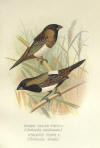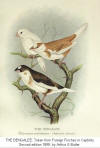THE BENGALEE.
Aidemosyne malabarica + Uroloncha striata, LINN.
This delightful little fertile hybrid was produced
by the Japanese, who, probably, carefully bred and selected for some
hundreds of years, until they developed the three well-known forms. These
are, firstly, white pied with purplish-brown, the patches of colour, as a
rule, being chiefly on the crown, leaving two large spots behind the beak on
the forehead ; the shoulder and thighs, the back, wing-coverts and
secondaries are similarly coloured. The second form is white, similarly pied
with fawn-colour, and the third is pure white. All three have flesh-tinted
beaks and legs, and black-brown eyes. The dark brown pied type is slightly
the largest, and has a dark upper mandible, and the white type the smallest.
The Bengalee has been called Pied Mannikin ; Dr.
Russ, who Regards the three forms as varieties of the Sharp-tailed Finch,
calls Them respectively " Spermestes acnticauda var. griseo-maculata" " var.
flavo-maciilata" and” var. alba; “but Mr Wiener regards them as varieties of
Uroloncha striata. Mr. Abrahams writes as follows : "In My opinion the
Bengalees is a cross between the Striated Finch (Munia StriataJ and the
Indian Silver-bill. If you look at the back of the Bengalees you will see
the distinctive marks of the Striated Finch."
Although I was personally inclined to think, from
the similarity of song, in what at first I took to be the Sharp-tailed
Finch, that the latter was one of the ancestors of the Bengalee, I
immediately yielded to Mr. Abrahams' far wider experience ; indeed, I have
since discovered that the song of the two species, U. striata and U.
acuticauda, is some- what similar.* Moreover, we must bear in mind the fact
that Dr. Russ associates " Spermestes striata, Spermestes melanopygia and
Spermestes acuticauda under one description, and says : " These three
species are universally known, and beloved in the bird trade, under the de-
nomination of Bronze Mannikins, mostly without being individually
distinguished." This is not, strictly speaking, correct, because in England
the true Spermestes (and more especially 5. cucullatd) are alone sold under
this name ; the Indian birds of the genus Uroloncha being probably
confounded by the small dealers, under the designation of "Sharp-tailed
Finches." The inferior size of all three varieties, and the fact that
(although domesticated) they are by no means prolific, seem to me strong
indica- tions that the Bengalee is not a pure descendent from the Striated
Finch. My first two pairs of Pied Bengalees were presented to me by the Hon.
Walter de Rothschild, and greatly delighted me by their tameness, and their
comical jerky little actions ; but Mr. Wiener's account of them made me half
afraid to turn them loose in my bird-room among the wild Mannikins and
Astrilds. This author says : " Through being bred by the Japanese in
miniature cages, the imported White and Pie- bald Mannikins seem to be
almost unable to fly, and consequently they are nearly as helpless in a
large aviary as a young bird just leaving the nest. They tumble into the
water, or hide in corners, or get into all sorts of scrapes."
Now, as I do not think that Crede experto is a
motto always to be followed, I concluded to turn my birds out and see what
would happen ; so I slid up the door and out they flew boldly, alighting on
the sand, upon which they hopped about for some time, occasionally taking
short flights on to the wire-netting, or on to some pea-sticks stuck in a
pot in one corner of the aviary. After about an hour of this play, one of
them suddenly flew directly upwards to a branch some ten feet overhead and
joined a party of Munias, and within ten minutes the three other birds had
followed his example. The next morning, when I entered the bird-room, I
looked round, somewhat anxiously, to see what had become of my new children
; I found the two cock birds singing their ridiculous song, which, to my
mind, resembles nothing so closely as it does the sound made by the little
woollen sheep on wheels, which one sometimes sees children dragging along
the pavement, dancing to their hens with a peculiar zigzag sort of approach,
and evidently quite at home. Presently one little fellow flew down to a
ledge close to me, looked up in my face and uttered a sound like whek. I got
him a rape seedling, which he took immediately from my fingers, and after
eating it flew to the fountain, had a drink, then a good wash, and was
shortly afterwards joined by his companions, and many other inhabitants of
the aviary.
So far from the Bengalees proving to be dull or
helpless, I have found them more fearless in perching upon the rim of the
glass bowl, into which the fountain falls, in venturing into the bowl
itself, more quick to comprehend the meaning of a seed-hopper, and stronger
on the wing than the majority of the small, newly imported finches. Before
many days were over, both pairs were busy building a nest in the same box,
where each hen laid one egg, hatched and reared it ; the two hens sitting
side by side, each on her own egg. This they did twice in the same year,
thus exactly doubling their numbers. The following year, only one Bengalee
left the nest, and was almost immediately killed by Zebra Finches. Although
many eggs were laid, these were all that I reared ; and some mouths
afterwards the Bengalees began to drop off one by one, until I only had a
pair of the dark, and a cock of the light form living.
From Wiener's and Russ' statements, one would
have expected unusual productiveness from these birds, and the want of it
puzzled me considerably ; eventually, however, I concluded that, as
Bengalees had for many generations been bred in cages, it was hardly fair to
turn them in with a number of rough wild birds, which, doubtless, often
disturbed them during incubation. I, therefore, tried my pair in a large
breeding-cage, where they built and laid eggs from time to time, but without
hatching them. I next purchased from Mr. Abrahams a pair of the white
variety, with the result that about three days later I found the cock bird
dead. I then took my net and entered the bird-room to catch my sole
remaining cock of the fawn and white variety. I could not help smiling, as I
thought of Wiener's " almost unable to fly"; for so quick was that bird in
avoiding me, that I was obliged to call my son in to catch it, whilst I
stood with a long cane at the other end of the aviary and repeatedly drove
it towards him.
Even thus, it took about twenty minutes to capture
it. I now paired this bird with the white hen, which died egg-bound on
February 26th, 1894. After the death of my white hen, I transferred my last
remaining pair of dark pies to the breeding-cage ; the hen laid numerous
eggs, and on October 2ist, 1894, one young bird left the nest; it was reared
chiefly on millet-seed ; another was reared towards the end of the year.
In 1886, a pair of the white variety, in a
flight-cage, reared two young, but only one at a time ; the first of these
died when about two months old. In another cage a pair of the fawn and white
variety associated with a Sharp-tailed Finch, the cock Bengalee paired with
the latter, which laid one egg ; this was hatched and reared by the
Bengalees, she then went to nest and laid four or five eggs ; three young
were hatched and reared ; lastly, towards winter, a fifth left the nest.
Excepting for a few extra white feathers, these cross-breeds resembled their
mother.
Bengalees are particularly fond of spray millet


